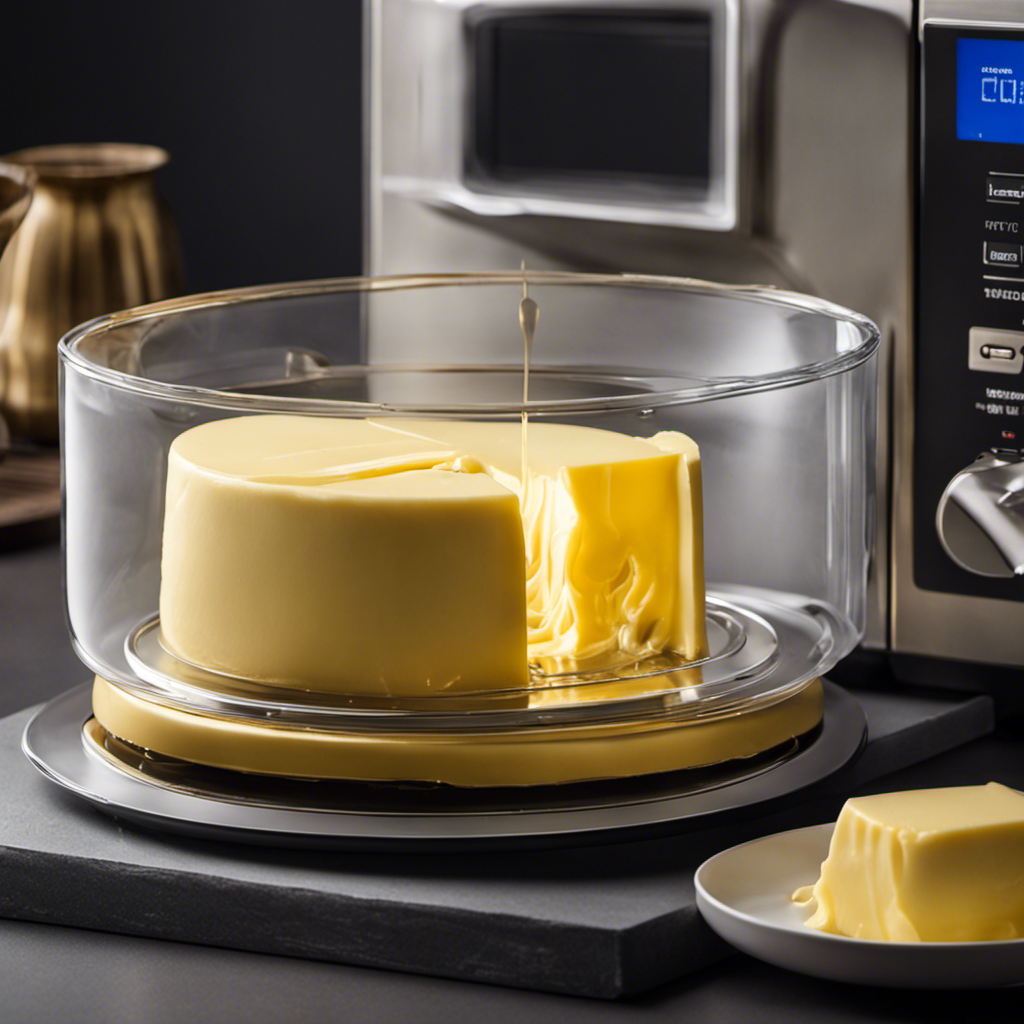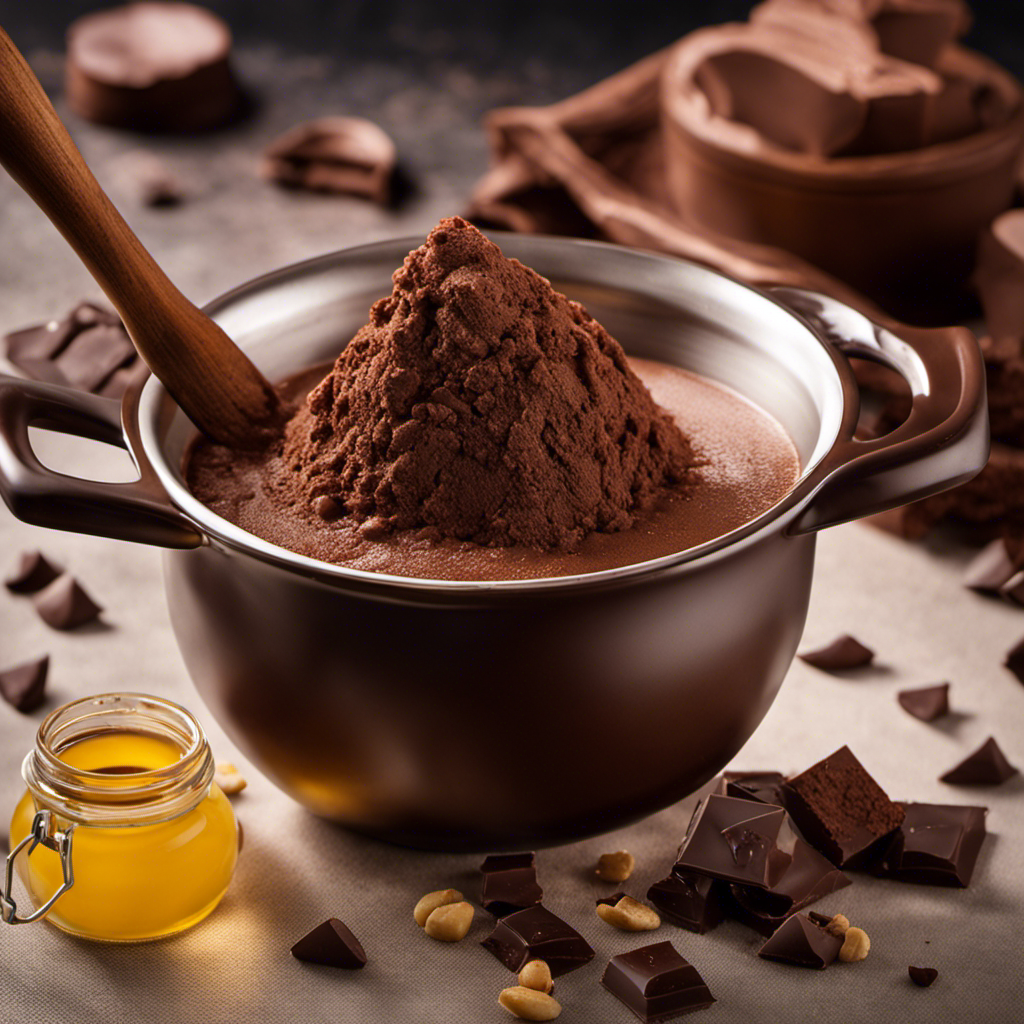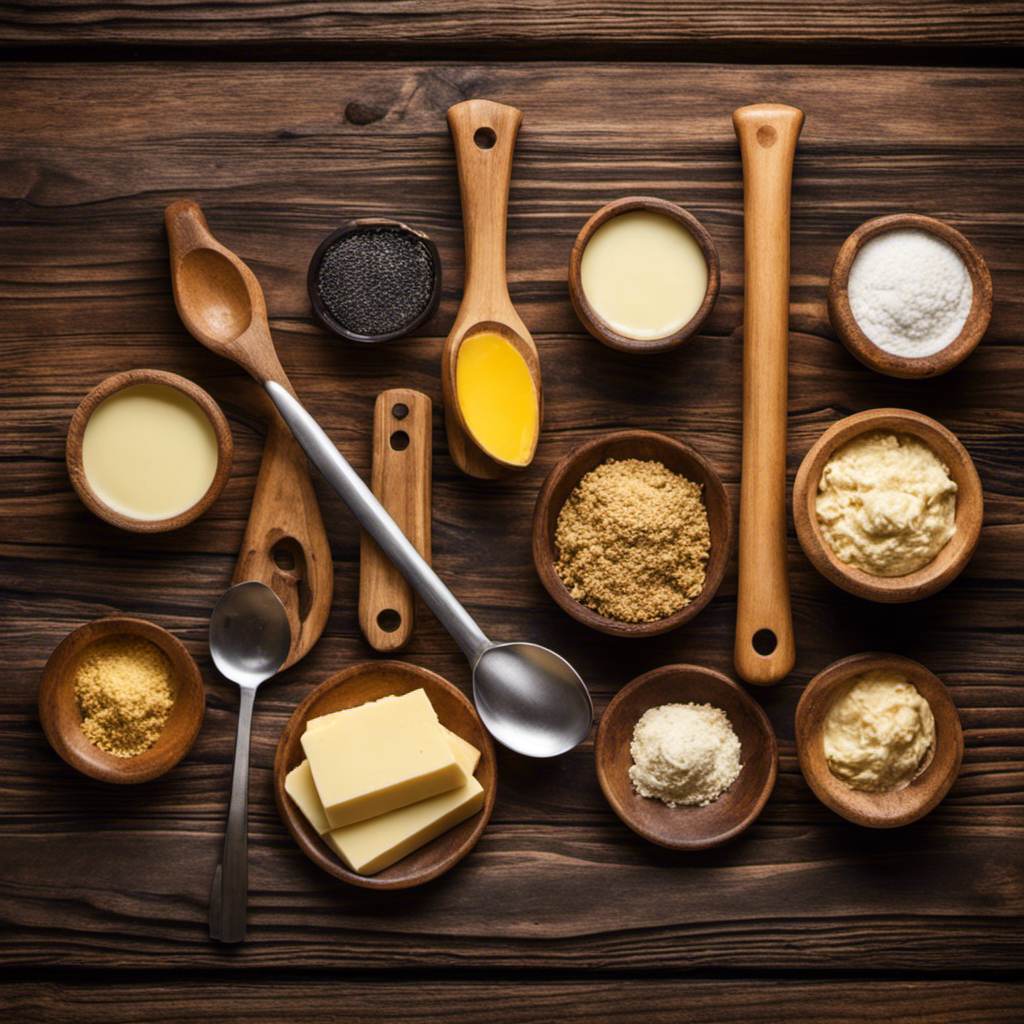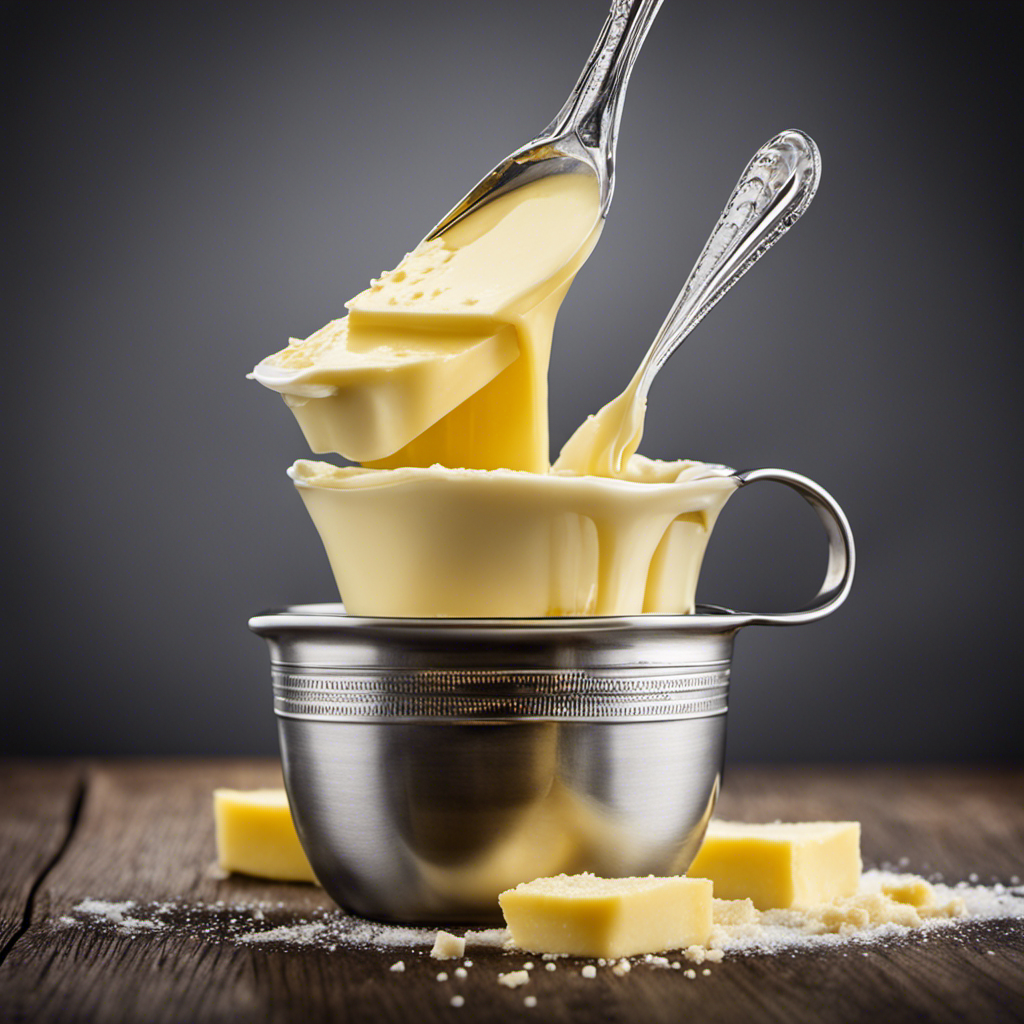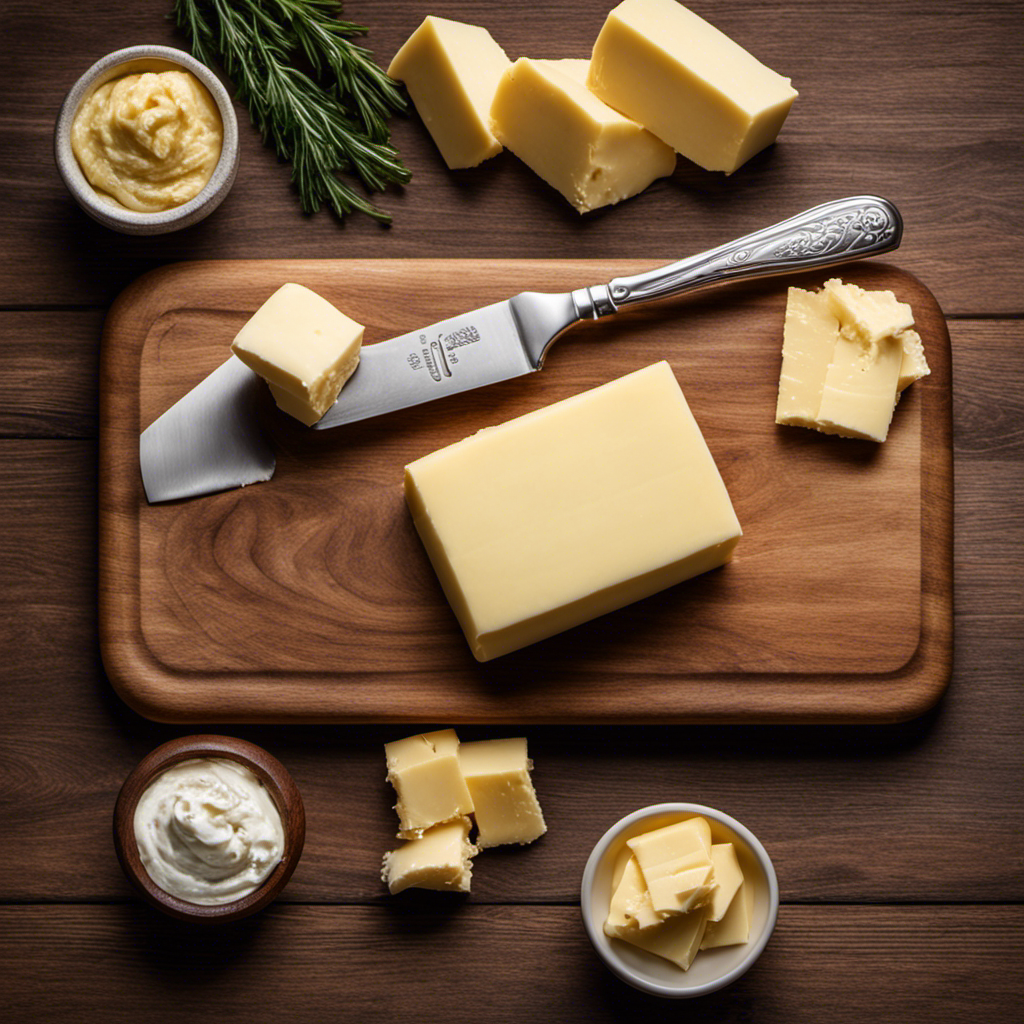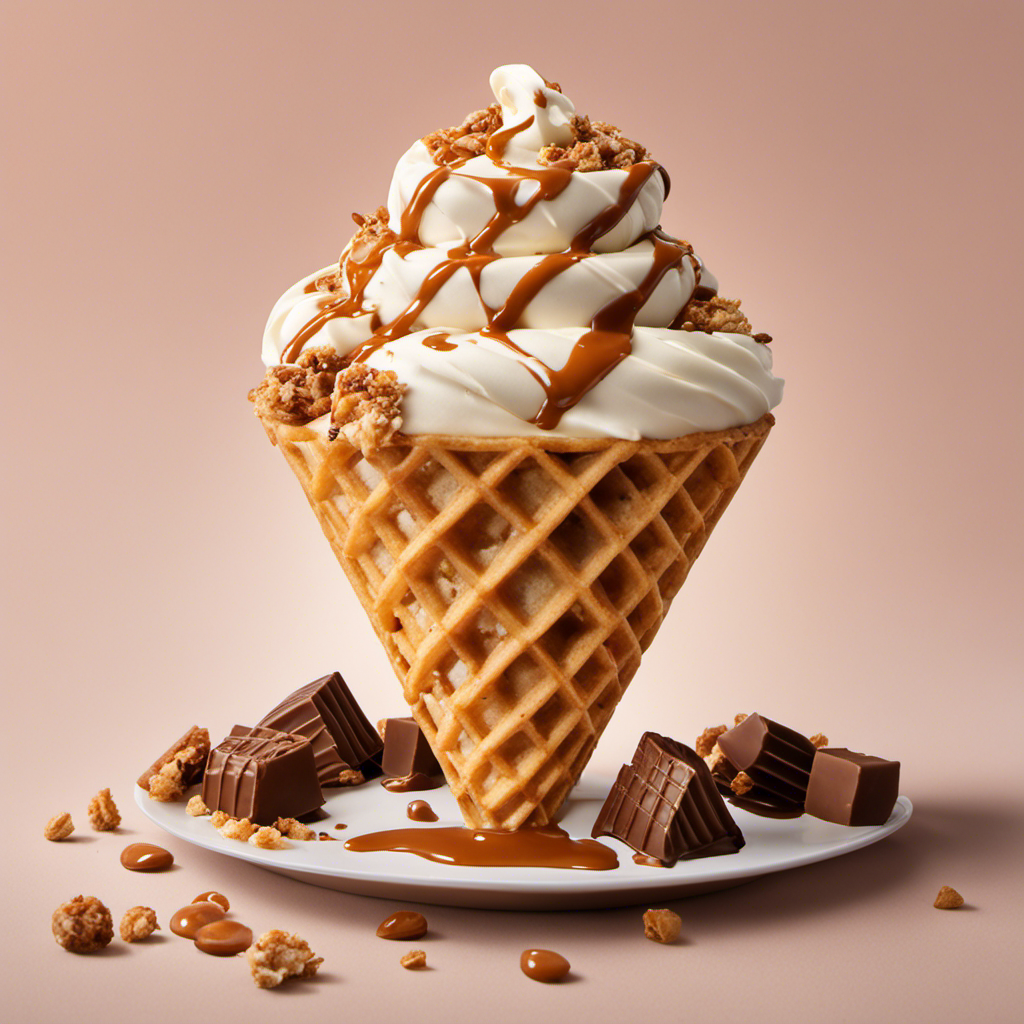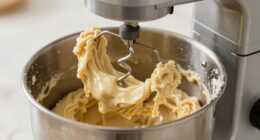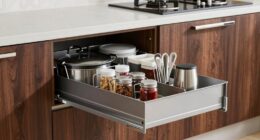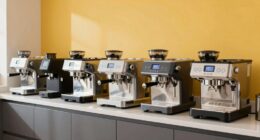I’ve discovered that the secret to achieving flawlessly melted butter is using the microwave. In this article, I’m going to walk you through the procedure, one step at a time.
First, I’ll show you how to select the right butter and cut it into small pieces.
Then, I’ll explain how to choose the right microwave-safe bowl and set the power level.
We’ll cover the butter and stir it in between intervals, ensuring a smooth consistency.
By the end, you’ll be ready to use the melted butter in your recipe with confidence.
Let’s get started!
Key Takeaways
- Consider whether to choose salted or unsalted butter.
- Cutting butter into small pieces ensures even and quick melting.
- Optimal power level determines melting speed and evenness.
- Melted butter adds moisture and tenderness to baking recipes.
Selecting the Right Butter
When selecting the right butter, it’s important to consider the type of butter you prefer. One key decision to make is whether to choose salted or unsalted butter.
Salted butter has salt added to it, which can enhance the flavor of your dishes. On the other hand, unsalted butter gives you more control over the saltiness of your food, allowing you to adjust the seasoning to your taste.
Another factor to consider is the butter’s moisture content. Butter with higher moisture content tends to have a softer texture and can be easier to spread. However, butter with lower moisture content is better for baking, as it helps create flakier pastries and pie crusts.
Understanding these differences will help you make an informed decision when selecting the right butter for your needs.
Cutting Butter Into Small Pieces
To make it easier to melt, I always cut the butter into small pieces before putting it in the microwave. This simple step helps the butter to melt evenly and quickly. When the butter is in small chunks, it exposes more surface area to the heat, allowing it to melt faster. Not only does this save time, but it also ensures that the butter is evenly melted, which is important for baking and cooking.
Another effective method for melting butter is to use a double boiler. This involves placing a heatproof bowl over a pot of simmering water, allowing the steam to gently melt the butter. Both of these techniques are great options for melting butter, depending on your preference and the recipe you are preparing.
Choosing the Right Microwave-Safe Bowl
When it comes to choosing the right microwave-safe bowl, there are a few key points to consider.
First, the material of the bowl should be safe for use in the microwave to avoid any potential health risks.
Second, the size of the bowl should be appropriate for the amount of food you plan to heat or cook in the microwave.
Material for Microwave-Safe
You can use a microwave-safe container to melt the butter. When choosing materials for microwave-safe containers, it is important to consider their safety and potential dangers.
Certain materials, such as glass and ceramic, are generally considered safe for microwave use. These materials are designed to withstand the heat generated by the microwave and do not release harmful chemicals when heated. However, it is important to check for any cracks or damage in the container, as this can compromise its safety and effectiveness.
Additionally, it is best to avoid using containers made of metal or plastic, as they can cause sparks or release toxic substances when heated in the microwave.
Size of the Bowl
Using a small bowl can help ensure even heating in the microwave. When melting butter, the size of the bowl plays a crucial role in achieving optimal results. A smaller bowl allows for better heat distribution, which means the butter will melt more evenly. Additionally, the microwave power and butter melting time can also be affected by the size of the bowl. A larger bowl may require more time and power to melt the butter completely. Therefore, it is recommended to use a small microwave-safe bowl to ensure efficient and consistent melting of butter.
Now, let’s move on to discuss the next important factor in melting butter: heat distribution efficiency.
Heat Distribution Efficiency
A smaller bowl ensures better heat distribution, resulting in more even melting. When it comes to melting butter in the microwave, heat distribution is a crucial factor to consider. Using a smaller bowl provides several advantages in terms of heat distribution. Here are some reasons why it is beneficial:
- Faster melting: A smaller bowl allows the butter to be exposed to more heat, resulting in quicker melting.
- Reduced hot spots: With better heat distribution, hot spots are minimized, preventing the butter from melting unevenly and potentially burning.
- Consistent texture: Even melting ensures a uniform texture throughout the butter, making it easier to incorporate into recipes.
- Efficient energy usage: A smaller bowl requires less energy to heat up, making it a more energy-efficient option.
- Precise control: With better heat distribution, it becomes easier to control the melting process and prevent any overheating.
Setting the Microwave Power Level
When it comes to melting butter in the microwave, finding the optimal power level is crucial. The power level determines how quickly and evenly the butter will melt, avoiding any unwanted splattering or burning.
Additionally, knowing the appropriate microwaving duration for butter is essential to prevent overheating or undercooking.
Optimal Power Level
To get the best results, it’s important to adjust the power level when melting butter in the microwave. The optimal power level will depend on the wattage of your microwave and the temperature of the butter. Here are some key considerations to keep in mind:
-
Microwave wattage: Higher wattage microwaves will melt butter faster, so adjust the power level accordingly. Lower wattage microwaves may require a slightly longer melting time.
-
Butter temperature: If the butter is cold, it will take longer to melt. To speed up the process, let the butter come to room temperature before microwaving.
-
Even heating: Stir the butter periodically during microwaving to ensure even heating and prevent hot spots.
-
Container choice: Use a microwave-safe container to melt the butter. Glass or ceramic containers are ideal, as they distribute heat more evenly.
-
Covering the butter: If desired, cover the container with a microwave-safe lid or microwave-safe plastic wrap to prevent splattering.
By adjusting the power level based on these factors, you can achieve perfectly melted butter in the microwave.
Now, let’s move on to discussing the appropriate microwaving duration for butter.
Microwaving Duration for Butter?
In the previous subtopic, I discussed the optimal power level for melting butter in the microwave. Now, let’s move on to the microwaving duration for butter.
It’s important to note that the duration will vary depending on the amount of butter and its starting temperature.
To begin, ensure that the butter is at room temperature before microwaving. If the butter is too cold, it may not melt evenly. Next, place the butter in a microwave-safe bowl and cover it with a microwave-safe lid or microwave-safe plastic wrap.
When microwaving, start with short intervals of 10-15 seconds on medium power. After each interval, check the butter’s consistency and stir it gently until completely melted. This will help prevent overheating and ensure a smooth texture.
Remember, microwaving times can vary, so it’s crucial to monitor the butter closely.
With these microwaving techniques and proper butter temperature, you’ll achieve perfectly melted butter in no time.
Covering the Butter With a Microwave-Safe Lid or Paper Towel
Make sure you’re using a microwave-safe lid or paper towel to cover the butter while melting it. This simple step is crucial in preventing butter explosions and avoiding hot spots. By covering the butter, you create a barrier that allows the heat to evenly distribute, preventing any sudden eruptions or splatters.
Here are five reasons why using a microwave-safe lid or paper towel is essential:
- Safety: It protects you from potential burns caused by the hot butter splattering.
- Cleanliness: It keeps your microwave clean by preventing any butter residue from splattering all over the interior.
- Efficiency: It helps the butter melt faster and more evenly, saving you time in the kitchen.
- Consistency: It ensures that the butter melts uniformly, resulting in a smooth texture for your recipes.
- Versatility: It can be used for other dishes as well, allowing you to cover and heat various foods without any mess.
Microwaving the Butter in Short Intervals
When it comes to melting butter in the microwave, it’s important to consider the optimal time intervals to achieve the desired results. By microwaving the butter in short intervals, we can prevent any splattering that may occur and ensure a safer and cleaner process.
Additionally, this method allows for the butter to be evenly melted, resulting in a smoother and more consistent texture for your recipes.
Optimal Time Intervals
To achieve the best results, it’s important to use optimal time intervals when melting butter in the microwave. Here are some key points to keep in mind when it comes to microwave safety precautions and troubleshooting microwave melting:
- Always use a microwave-safe container to avoid any potential hazards.
- Cut the butter into smaller pieces to ensure even melting.
- Start with shorter time intervals, around 10-15 seconds, to gradually melt the butter.
- Pause and stir the butter after each interval to prevent overheating and ensure even melting.
- If the butter is not fully melted after the initial intervals, continue with shorter intervals until the desired consistency is reached.
Prevent Butter Splattering
Using a microwave-safe cover will help prevent any butter splattering while heating it, preventing butter explosions and minimizing butter loss. When butter is heated in the microwave without a cover, the heat causes the water content in the butter to turn into steam. This steam can cause the butter to splatter, creating a mess and potentially causing burns. To avoid this, simply cover the butter with a microwave-safe lid or a microwave-safe plate. This will trap the steam and prevent it from escaping, minimizing the chances of splattering. By taking this precaution, you can safely melt butter in the microwave without any messy accidents.
Now, let’s move on to the next section and explore how to achieve evenly melted butter.
Evenly Melted Butter
Achieving evenly melted butter is important for ensuring consistent results in your recipes. When butter is unevenly melted, it can lead to burnt spots or a greasy texture in your dishes. To prevent this, here are some tips:
- Use a microwave-safe bowl and cut the butter into smaller pieces for faster and more even melting.
- Microwave the butter in short bursts of 10-15 seconds, stirring in between, to avoid overheating and burning.
- If your microwave has a low power setting, use it to melt the butter slowly and evenly.
- Cover the bowl with a microwave-safe lid or microwave-safe plastic wrap to trap the heat and aid in even melting.
- Allow the melted butter to sit for a minute or two before using it, as residual heat will continue to melt any remaining solid pieces.
Stirring the Butter in Between Intervals
Make sure you stir the butter in between intervals to ensure it melts evenly. Stirring the butter prevents overheating and avoids it from solidifying. When melting butter in the microwave, it’s important to remember that microwaves heat unevenly, which can result in some parts of the butter melting while others remain solid. To prevent this, pause the microwave every 15-20 seconds and give the butter a quick stir. This will distribute the heat evenly and help the butter melt consistently. By stirring regularly, you can also prevent the butter from getting too hot and potentially burning. So, to achieve perfectly melted butter in the microwave, don’t forget to stir it in between intervals.
| Time (seconds) | Stirring Required |
|---|---|
| 0-15 | Yes |
| 15-30 | Yes |
| 30-45 | Yes |
| 45-60 | Yes |
Checking the Butter’s Consistency
When checking the consistency, make sure the butter has fully melted and is smooth. To ensure that the butter is at the right temperature and consistency, here are some key things to look out for:
- The butter should be completely melted and have a liquid consistency.
- There should be no visible solid chunks or lumps in the melted butter.
- The color of the melted butter should be a light, golden yellow.
- When touched with a spoon or a whisk, the butter should feel smooth and flowing.
- If you dip a finger into the melted butter, it should feel warm to the touch.
Adjusting the Microwave Time if Needed
If the desired consistency is not achieved, you may need to adjust the time in the microwave. To do this, simply put the butter back in the microwave for an additional 10-15 seconds and check again. Repeat this process until the butter reaches the desired consistency.
It’s important to note that microwaves vary in power, so you may need to adjust the time accordingly.
If you find that the butter is becoming too soft or melting too quickly, you can also try alternative methods for melting butter. One such method is using a double boiler, where you place the butter in a heatproof bowl over a pot of simmering water.
Another method is to melt the butter slowly on the stovetop using low heat. These methods allow for more control over the temperature and ensure that the butter doesn’t overheat or burn.
Using the Melted Butter in Your Recipe
To incorporate the melted butter into your recipe, simply pour it into the mixture and stir until well combined. Melted butter is a versatile ingredient that adds richness and flavor to various dishes. Here are some ways to use melted butter in baking and incorporate it into sauces:
-
Baking:
-
Use it in cake and cookie recipes for a moist and tender texture.
-
Brush melted butter on breads and pastries for a golden crust.
-
Add it to pie crusts for a flaky and buttery result.
-
Sauces:
-
Make a simple lemon butter sauce by combining melted butter, lemon juice, and herbs. Drizzle it over fish or vegetables.
-
Use melted butter as a base for creamy pasta sauces or hollandaise sauce.
Incorporating melted butter enhances the taste and texture of your dishes, making them more indulgent and delicious.
Frequently Asked Questions
Can I Use Margarine Instead of Butter to Melt in the Microwave?
Yes, you can use margarine instead of butter to melt in the microwave. However, it’s worth considering the margarine vs butter debate and the health benefits of using margarine instead of butter.
How Long Does It Take to Melt Butter in the Microwave?
To melt butter, I usually prefer using a saucepan instead of a microwave. It allows for better control and avoids overheating. However, if you prefer using a microwave, there are alternative methods available.
Can I Melt a Large Block of Butter in the Microwave or Do I Need to Cut It Into Smaller Pieces?
I can melt a large block of butter in the microwave, but it’s best to cut it into smaller pieces for even melting. Alternatives to the microwave include melting butter in the oven or on the stovetop.
Is It Necessary to Cover the Butter While Microwaving It?
Covering the butter while microwaving is not necessary. However, it can prevent splattering. It is recommended to use a microwave-safe bowl to melt the butter, as using a glass bowl may cause it to shatter.
Can I Use a Plastic Bowl Instead of a Microwave-Safe Bowl to Melt the Butter?
Can I use a plastic bowl instead of a microwave-safe bowl to melt butter? While it may seem convenient, using a plastic bowl can be risky. It’s important to prioritize safety and use alternative microwave-safe materials.
Conclusion
In conclusion, melting butter in the microwave is a simple and convenient method that can save you time in the kitchen. By following the proper steps, such as selecting the right butter, choosing a microwave-safe bowl, and adjusting the power level, you can achieve perfectly melted butter for your recipes.
Don’t be afraid to stir and check the consistency along the way, ensuring a smooth and creamy result. Just remember, like butter on a hot biscuit, this technique will make your cooking experience a breeze.
